Normally Cape Town celebrates spring on the first day of September, but this year for some unknown reason the equinox or 21st of September seems to be the official start of spring.
Please note that the prices below have changed for the 2015 season.

Conservation fees and other info for the West Coast Reserve
Whether we celebrate spring on either of the two dates above makes absolutely no difference to nature here in Cape Town. From early in August the wild flowers start coming into bloom and last through to the end of September.
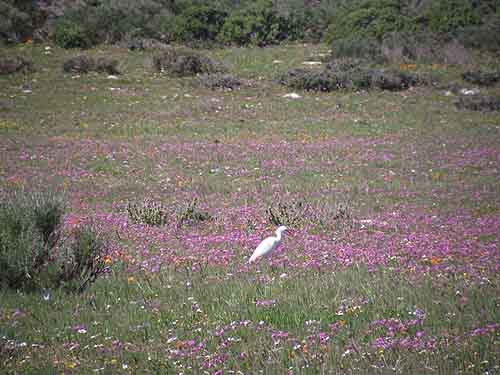
Field of pink flowers in Postberg
There are a number of places in and around Cape Town where one can see the wild flowers. In fact just driving around the northern suburbs of Cape Town will show you some of nature's bounty. Open spaces alongside roads are covered in yellow and white daisies while some of
the smaller nature reserves and local parks are also full of daisies and other small flowers.

Field full yellow crassulas
One of the best places to view carpets of flowers however is in the Postberg which is in the West Coast Nature Reserve.
The reserve is open all year round but Postberg only opens from the 1st of August till the end of September.

Another field of mixed colour flowers
Postberg is a privately owned piece of land of about 6000 hectares inside the national park which is normally closed to
the public but during the flower season plays host to thousands of enthusiasts looking for the flowers.

Wildebeest grazing in a sea of pink
This year has been no different. There are carpets of flowers everywhere in the Postberg park with lots of pinks and orange and
yellows sometimes for as far as the eye can see. Postberg however has one special attraction for me and its not the flowers or the beautiful views.
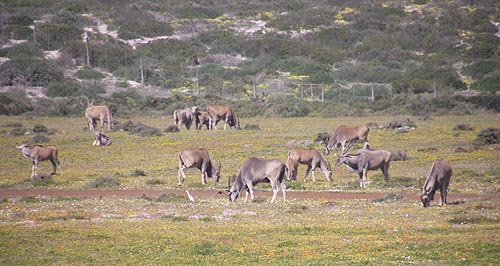
Part of Postberg Reserve's majestic Eland herd
It's the “Eland” a majestic antelope which one seldom sees in the wild. There are one or two of them in the Cape of Good Hope Nature Reserve
and a few on other game or wine farms around Cape Town but in all my years I have never seen so many of these magnificent beasts all together
in one place at the same time.
Postberg must have at least thirty eland within its 6000 hectares with most of them congregating near the entrance to the Postberg Reserve.
If I was a San hunter I would be in seventh heaven as the eland would become my favourite meal. As I am not a San hunter I am happy to see
this large herd grazing peacefully among the flowers in the Postberg.
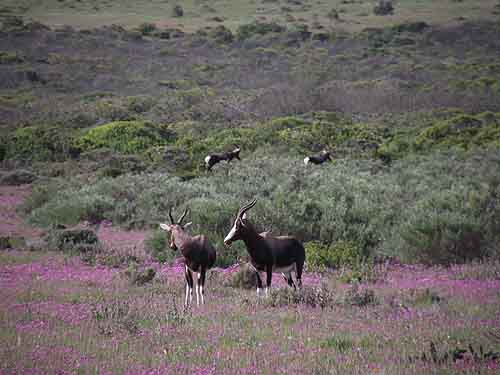
Bontebok
Not only will you see eland but also zebra, bontebok, wildebeest and springbok in the veld amongst the flowers. Its a privilege to see the
Bontebok as just a few years ago this attractive brown and white antelope was facing extinction.

Beautiful zebras grazing in Postberg
Other wildlife on Postberg that I spotted during my visit were tortoises, pheasants, sacred ibis and guinea fowl to name a few.
There are many lizards and snakes to be found in the park although the snakes are very shy and seldom seen.
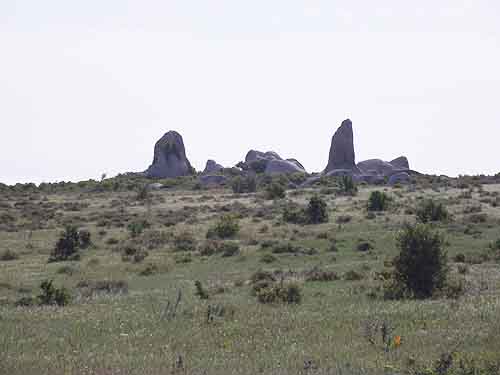
Rock formations in the Postberg Reserve
There are some interesting rock formations near the highest point of the Postberg Reserve. The rock fingers pointing skywards and the other
large boulders close by remind one of Stonehenge in Britain. I don't think our rock formations having the same significance as Stonehenge does.
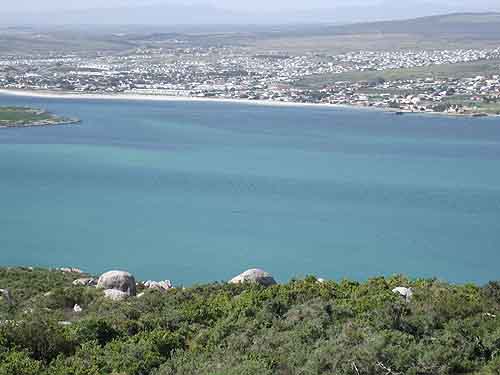
The Langebaan Lagoon
From the lookout point at the top of the highest point of the reserve one gets some fantastic views out over the islands dotted around the
Langebaan lagoon and also of the iron ore terminal at the northern end of the lagoon near Saldanha Bay. The Langebaan lagoon is absolutely
stunning with its blue waters and white beaches and the Langebaan village clinging to the shoreline on the eastern side of the lagoon.

Kraalbaai with its houseboats
The coastline on the western shore of the lagoon is still more or less as nature left it. It has very few buildings and the mountainous area which makes up the highest point of the Postberg reserve is still pristine natural bush.
When the attraction of Postberg and the flowers is over the West Coast reserve will once again become the attraction. There are a number of beautiful bays along the western coastline of the lagoon and one of them named Kraalbaai
has been set up as an anchorage for a number of houseboats which are available for hire from Sanparks who run the park.
On the southern coastline of Kraalbaai is another strange rock formation known as the preekstoel (pulpit) and it is here on the banks of the lagoon
that early human footprints were discovered a number of years ago. The discovery caused much excitement at the time. In fact there are a number of
sites in and around Langebaan where bones of prehistoric man and animals have been found.
As mentioned earlier the lagoon once was home to a whaling station near Donkergat but fortunately with the ban on whaling around our coastlines we
from time to time now have whales swimming into the lagoon. Between May and November the Southern Right whales visit our shores to give birth and
mate and many of them make their way up the west coast and can be seen along our Atlantic coastline.
For those not interested in the flowers or whales or the other wildlife in the park there are hundreds of birds that live and breed in the wetlands
along the southern coastline of the lagoon. Many of them fly in from as far abroad as Russia. What a privilege it is to sit in a hide and observe
the bird life going on around you. Not only is it a stress free experience but something that will help you appreciate nature doing its thing.
The West Coast Reserve is approximately a 100 kilometres from the city, about an hour's drive and is well worth a visit especially during the
summer months when one can relax on the beaches and bays of the lagoon. For those with boats, the lagoon is navigable although there are
restrictions as to where you can use motorised boats.
For anglers, there are large banks where bait (prawns) can be collected and if you can reach the channels when the tide comes in you are
likely to catch yourself some supper.
The next time you visit Cape Town take a trip up the west coast and see a completely different world to what you would have
experienced in the Peninsula.

